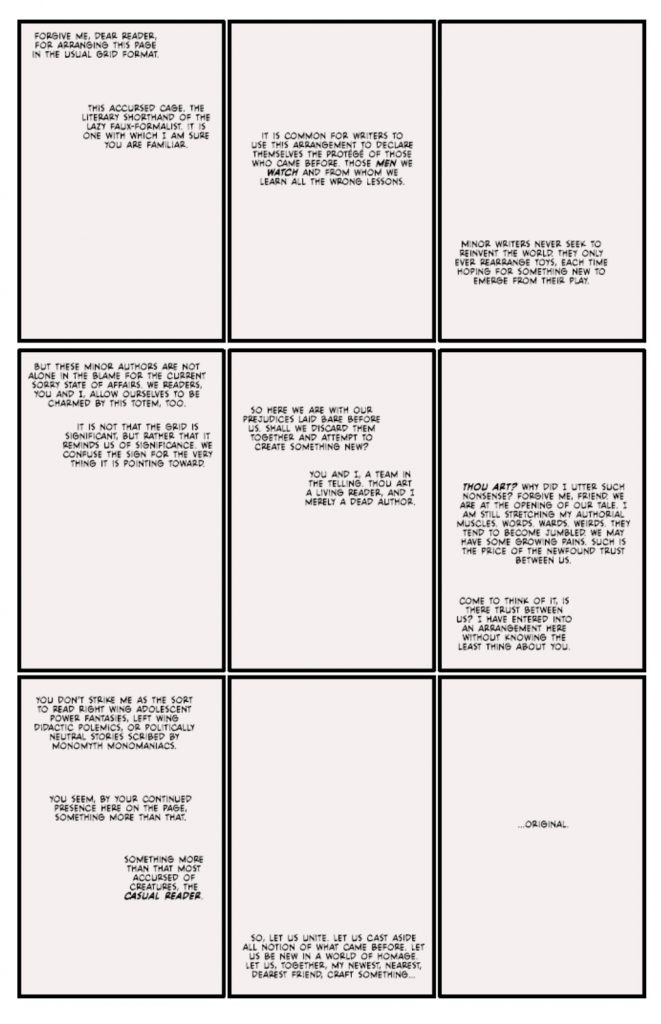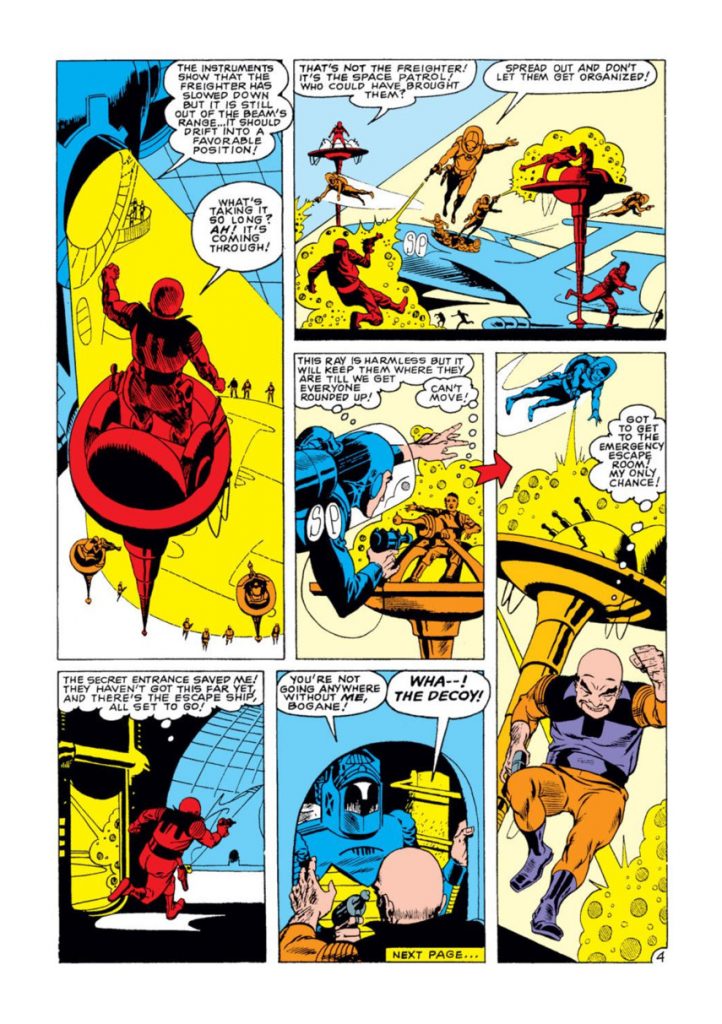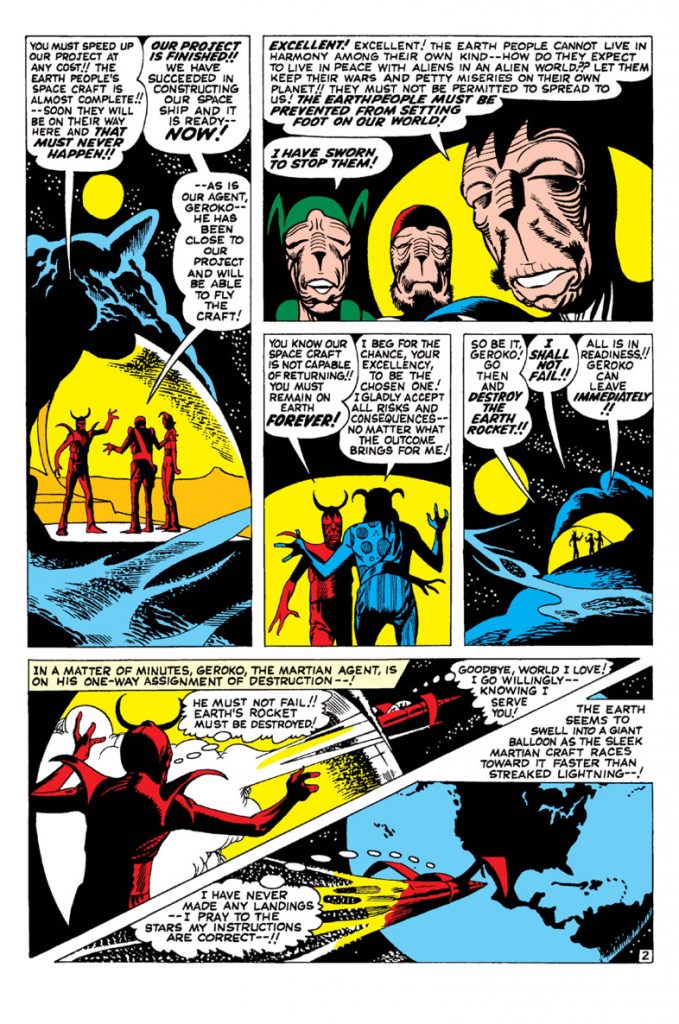Are you down with the NPG?
Deconstructing the nine panel grid by looking through the history of the structure and its varied uses.
We all know it. Its appearance is a sure sign that this is a serious comic, a work of art with something to say. It’s often seen as a sign of “sophistication.” It’s three panels wide and three panels tall. It is, of course, the nine panel grid. 21.

When we think of the NPG, the comic that looms larger than any other is Watchmen. But the history of the grid actually goes back a lot further than 1986.
While not the first to use the grid, Steve Ditko used it extensively throughout his career, going as far back as early issues of Tales to Astonish and Tales of Suspense in the late 1950s. It isn’t the extensive use associated with Watchmen, where each page is built on the grid, but instead it’s a page layout that Ditko often used for a specific effect. As he drew more comics, Ditko started using mainly the six panel grid and the nine panel grid, 22 changing between them depending on what the story called for. Ditko used it mostly for exposition or more mundane scenes, and then he would break out the bigger panels for action sequences. Sometimes he even did this on the same page, having a modified or combined version of both grids, with two rows of three panels and then a row of two panels. 23
Ditko wasn’t sticking to the “rules” of the NPG in the same way that many who came after him did, mainly because when he did it, there weren’t any rules. He was simply telling the story to the best of his 24 abilities. If that meant mixing grids, then that’s what he did. Being one of the first to use the NPG extensively meant that Ditko was, for the most part, just using it as three rows of three panels. But sometimes it also meant that he was doing things with the grid that either didn’t really work (as in the page below to the left) or something that’s pushing the boundary of what’s possible in the NPG, yet worked perfectly (as in the page below to the right). Being a pioneer is high risk, high reward.
-

From Steve Ditko’s Tales to Astonish #4 -

From Steve Ditko’s Tales to Suspense #4
Ditko is far from the only one to have used the NPG before Watchmen. Two notable comics that used it were Eddie Campbell’s Alec and Los Bros Hernandez’ Love and Rockets. 25
Love and Rockets have stretches where the NPG is used in much the same way we know it now. As something present on every page, with panels that can be merged as need be, with the top row merging for a page wide establishing panel or some such. It gives the pages a uniform look, allowing the reader to focus on the content, changing the grid rarely and for a specific effect, as the story moves from smaller, more intimate moments to more bombastic ones.
subscribers only.
Learn more about what you get with a subscription
Which I’ll refer to as the NPG going forward.↩
Especially as Amazing Spider-Man went on.↩
Sometimes these pages serve as a segue between the NPG pages and the six panel grid pages.↩
Considerable.↩
Both from the early/mid-80s, meaning they’re a few years before Watchmen.↩
As much as any life can be straightforward, especially when it’s about a cartoonist and the guy that co-created From Hell.↩
Which also does amazing things with the NPG.↩
Though that might not be such a bad idea… Hmmm… ↩
As much as a lifetime of reading and studying comics counts as research, anyway.↩
To the consumer. The team has to put in extra work, which is considerable.↩
As mentioned in how Ditko used it, for instance.↩
So. Much. Research! Did you know that there are a lot of comics that use nine panel grids?↩
Hell, sometimes there were even pages with three panels of story and then a big establishing panel with a scene change and then another three panels in the new scene. Something that’s usually advised against doing on a page, but which works with the NPG.↩
And to a certain extent, also going diagonally, but that’s not used as often.↩
And both panels even work as establishing panels of a sort too.↩
To name just one example.↩
This is definitely helped by Cooke changing the panel shape, but it’s only enhancing the effect, not creating it.↩
Though arguably, this isn’t a true triptych, as the image is actually split over all the remaining eight panels. ↩
Dead Dog’s Bite and The Seeds, to name just two.↩
Especially some of that early Ditko work.↩
Which I’ll refer to as the NPG going forward.↩
Especially as Amazing Spider-Man went on.↩
Sometimes these pages serve as a segue between the NPG pages and the six panel grid pages.↩
Considerable.↩
Both from the early/mid-80s, meaning they’re a few years before Watchmen.↩
